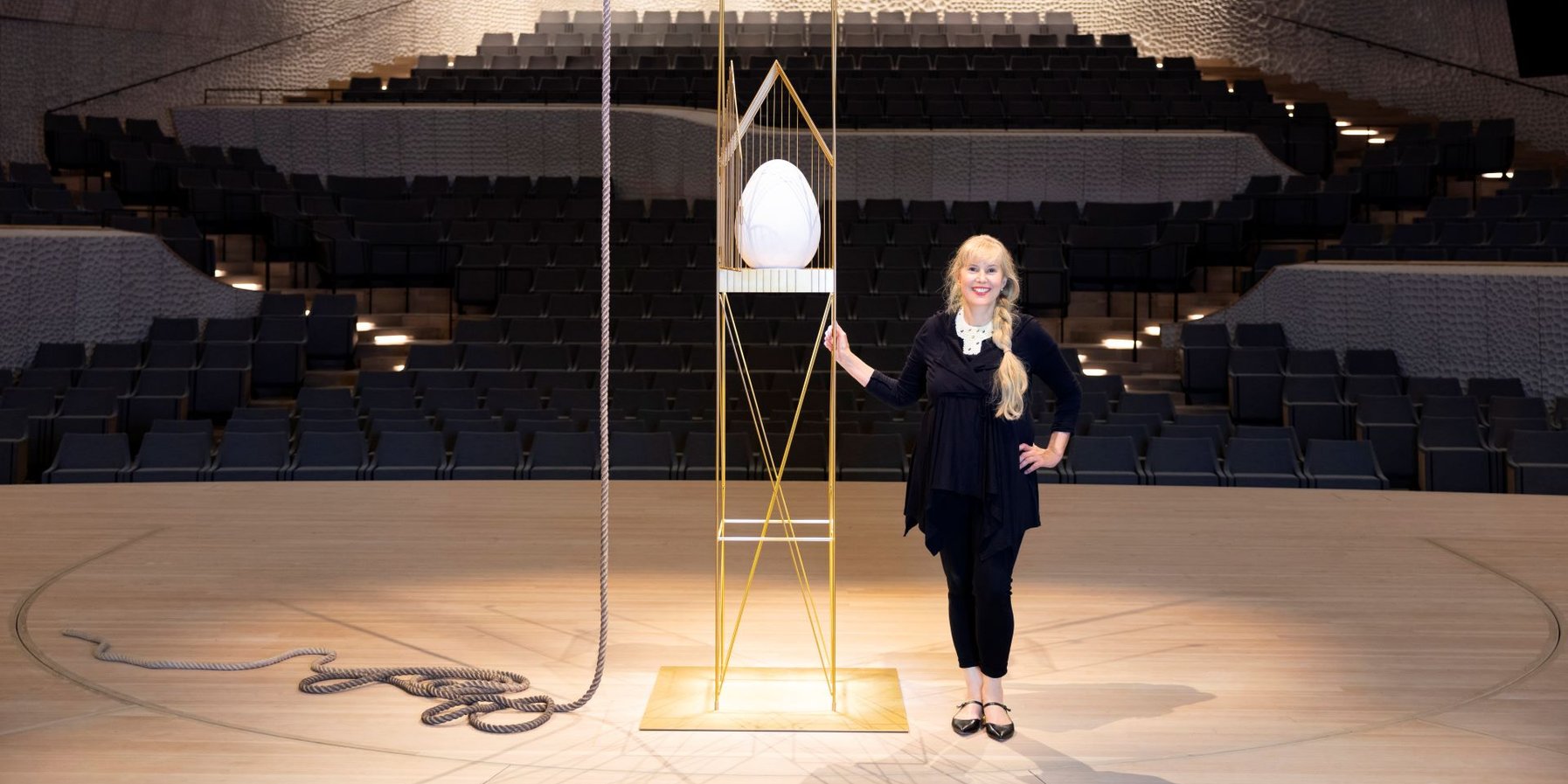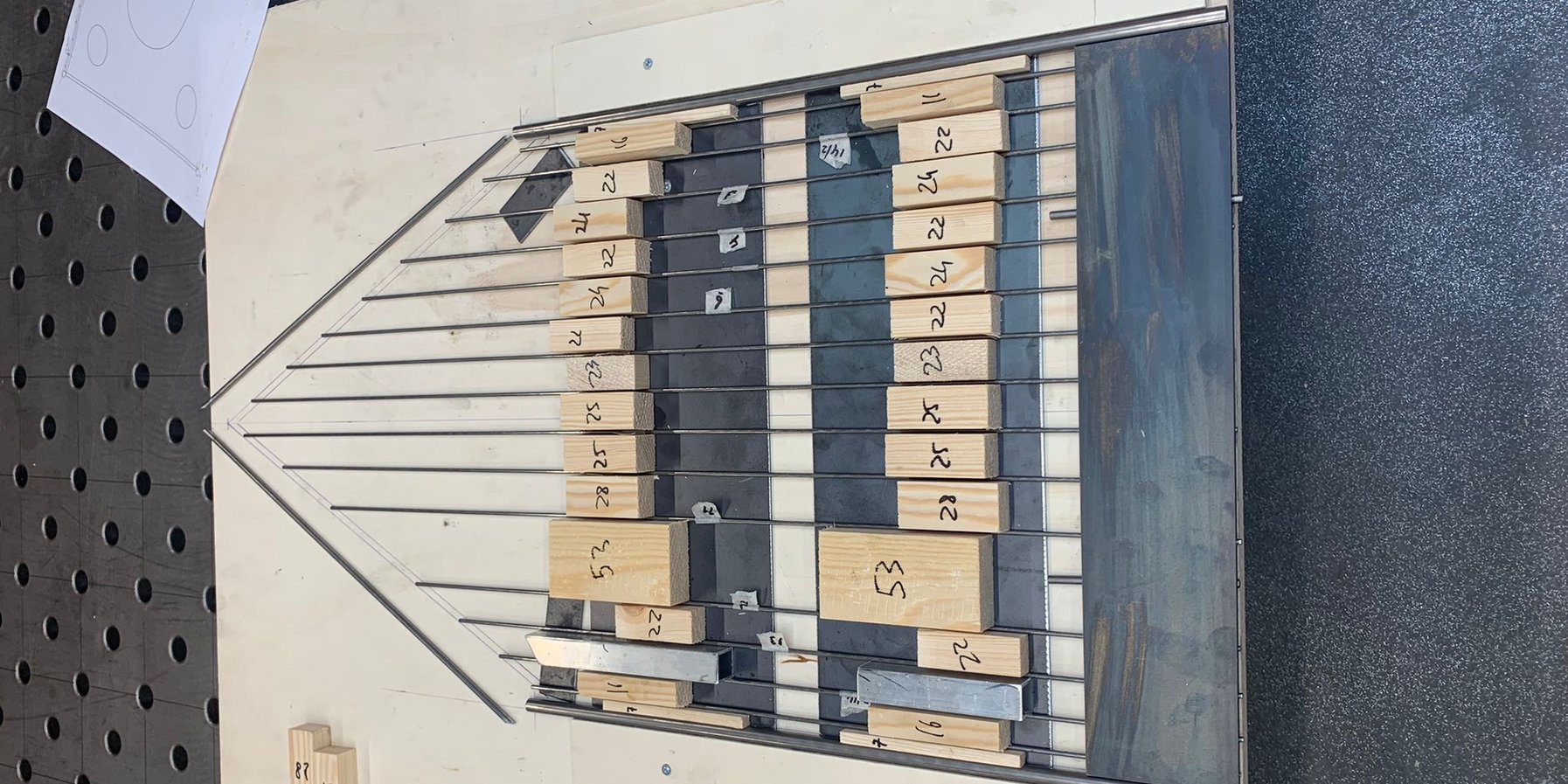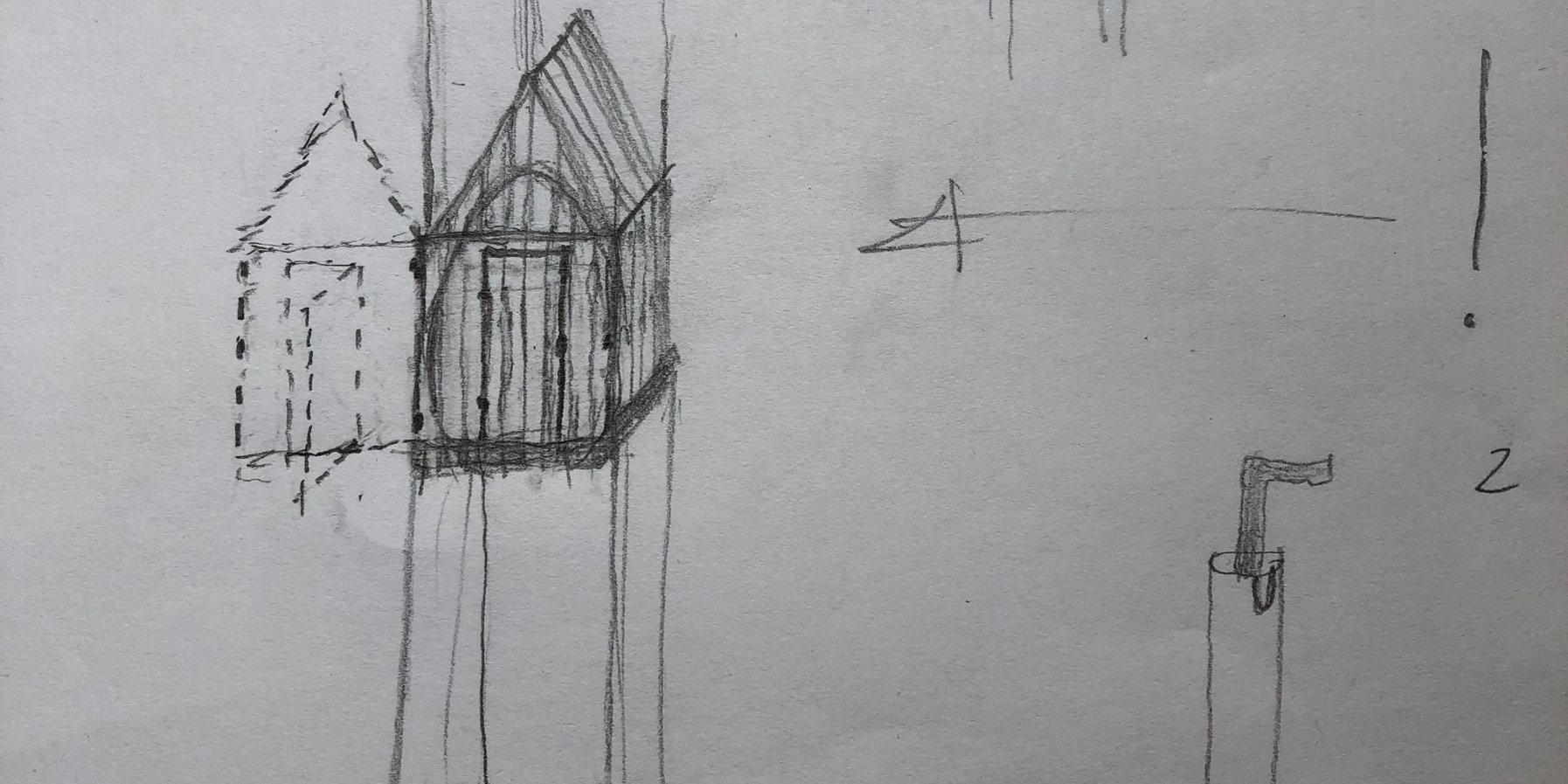Ensemble Resonanz knows from many years of experience that exchange keeps art alive. In one season after another, the award-winning Hamburg string collective enters into new artistic partnerships: the cellist Jean-Guihen Queyras, viola player Tabea Zimmermann and the conductor Riccardo Minasi have been among them.
Most recently, the ensemble decided to focus on the concert format as such: on the presence of the musicians in the two Elbphilharmonie auditoriums, on the ensemble as a body of musicians and on the interaction of music and scene, light and space. They have now found a partner in set designer and scenographer Annette Kurz, who has been exploring this field for many years as head of lighting and décor at the Hamburg Thalia Theater. This interview with her was held by Tobias Rempe, director and artistic manager of Ensemble Resonanz.
Hear them live
The egg is only the beginning: Annette Kurz and Ensemble Resonanz in the Elbphilharmonie.
Annette Kurz in interview
Annette, the production conditions at concert venues for artists like you tend to be pretty poor. What was your first thought when the ensemble approached you and suggested working together?
At the outset I thought it was going to be difficult. I obviously have an idea of how a concert venue works, and how different the conditions are compared with a theatre, where I am an integral part of the production process. But I see the invitation to work together with you in a concert hall as an invitation to find out what is possible. A mutual expedition, and a challenge that I am looking forward to!
You are known for large-scale and lavish sets in your theatre work. And now the remit is suddenly »little details with a large impact«: in a concert hall, time and materials, technical possibilities and the budget are limited. Is this the special challenge you’re talking about?
It’s true that I build a lot of really big sets and put large scenic objects on the stage – but I also once designed an entire room using just a roll of tape. It’s the right idea that’s most important!
I believe that any room needs to have a centre. That centre can be a matchbox or a pebble if you plan it right, if you discuss it with everyone involved and they all agree. There is a saying in theatre that the other participants play the king. The idea behind it is that the actor playing the king doesn’t really have so much to do. He needs the other people who believe in him or think he is capable of being this powerful and exceptional character. And that’s the way the principle of having a centre works: if we all decide that there is a centre and believe in it, then it exists.
That sounds exciting, as if you’re going to start by using what you find on the concert platform. Which elements are you going to add at different stages?
At five concerts during the season I am planning to explore a different aspect of scenography with you in each case: sculpture, light, projection, movement, make-up and other features of the encounter between music and visual media. People always underestimate lighting: it’s actually the most important factor among the visual arts on stage. Music elicits feelings, and these can be steered and intensified by lighting. I’m particularly looking forward to this playing field, which I am keen to explore further.
I’m not yet sure where costume and make-up will take us, but I had the impression that the musicians are interested in it. I plan to work on my first projection together with you, and I’m already quite excited about it. Then there is another point: I want to work together with people in relation to the space around them – what effect does that have on the architecture?
Annette Kurz and Ensemble Resonanz get to know each other
You described our cooperation as an expedition, a journey of discovery. That matches exactly our idea as an ensemble that we want to learn as much as we can and to profit to the maximum here. How can we deal with the different events on stage and with the picture of ourselves that we give on the concert platform? What skills can we learn – the musicians, and the backstage team? Or – this is a classic – can we learn to operate the technical equipment? We want to discover different possibilities step by step and find out what we can use again in future seasons.
What applies here to the ensemble applies to me as well: I don’t have any answers to these questions. I don’t know what direction the journey will take us in. But a space is opening up here where we can try out different things. Space means time, money and people participating. In my work for other theatres and opera houses this kind of space is increasingly rare. But here we can try things out and see what the result is – obviously led by the wish and determination to do the best we can. But for me at least, the journey is more important than the result. It goes without saying that there is an element of risk. How do you see it?
We want to create concerts together which produce special experiences, and in the process we aim to find a much more integral form of concert that is more convincing in every respect. But we are not going to shut ourselves up in a blackbox where we spend five days rehearsing, building a set and deciding on the lighting in order to come out with perfectly produced music theatre. There have been some interesting developments in the fields of concert design or staged concerts, but we are appearing here on a concert platform. That makes the process of trying things out and discovery important. And a willingness to take some risks is part of the ensemble’s working method from the outset.
You use the term »scenography« for your work, and for our coming cooperation. The term is not widely used in Germany yet. Why do you use it?
In the theatre, »set« or »stage set« is the term generally used, and this has its meaning and tradition. I studied in France, where the term »scénographie« is used instead. That is wider in coverage: it doesn’t just refer to a service or to set design. Instead, a space or an event is thought through from bottom to top. You start off with a dramaturgical nucleus, then progress to the resources you want to use – and these are highly diverse.
Your work with the ensemble, the beginning of this expedition, started at a one-day workshop in the resonanzraum. How was this first encounter for you?
In a first session with nearly 20 people I learnt that the ensemble is made up of individuals from different periods, from the founding members to the latest additions. It was great to feel how mixed and varied the ensemble is, while being homogeneous at the same time. I was overwhelmed by how open-minded and interested everyone was, as regards the visual level as well. For the first programme I developed a sculpture consisting of an egg and a golden cage. There was a great scene where each member of the ensemble wanted to hold the egg himself; it was passed on to the next person in turn, with each individual holding it in his own way. Then I realised once again how much the creation of the sculpture had to do with the ensemble itself.
The sculpture: An egg does the rounds
The egg with the cage can certainly stand for all kinds of things, and in a certain way it fits into our musical programme – e.g. with the content of the Mozart arias depicting the eruptive power of love. But I also see a symbol here of the way we work, bringing forth new things under very restricted circumstances.
It’s true that someone in the ensemble brought up the egg in discussion as an image for how we work together. It got bigger and bigger in my mind, and accompanied me on a trip through art history in search of corresponding pictures and painters.
I took the inspiration for the sculpture from Alban Berg’s »Lyric Suite«. This work represents the backbone of the evening for me, while the »Haffner« Symphony holds the programme together and the arias sparkle like stars. The »Lyric Suite« prompted me to explore the composer’s biography in detail to get a better understanding of the music. Berg depicted his clandestine love affair with Hanna Fuchs more or less one-to-one in this work, showing his passionate love, the different stages of the affair and the unrequited nature of his love. You can see all this ...
... and hear it.
Only once the cage with the egg was finished did I think of taking the sculpture with me through the season and to other venues; I also had the idea of altering it. One thing leads to another. For me, this organic cooperation is like a gift for the creative process.
You also once said that the sculpture belongs to the ensemble, that it’s an additional actor on the stage like soloist Anna Prohaska or like Riccardo Minasi.
This sculpture is like a mental centre for me. I deliberately gave it almost human proportions: the body is at face height, and the cage stretches its arms upwards like a Giacometti figure. In this way the sculpture can be incorporated wonderfully into the ensemble and seen as a member of the ensemble. It’s someone who drops in and you can choose to play with him or not, you can just leave him standing there and look at him and think about him. Anything is possible.
Making-of: A sculpture for Ensemble Resonanz
After these first experiences working together with us, what differences do you see from the way you normally work in theatres?
The no. 1 difference is that I have to work out the narrative for myself. In the theatre there is always a play or novel or another text that the forms the basis of what happens on stage. There is a producer who has read the piece and who shares his view of it, providing me with an approach. It may all seem entirely logical to you: you see the notes, you know the music and the background. But I’m not a musician, and I feel like an Egyptologist deciphering hieroglyphs in an alien world which is not completely unknown to me. This situation gives me great freedom that fulfils and inspires me, but it comes with a great responsibility as well.
So you feel that you have a bit more freedom, despite the circumstances?
Creative freedom, absolutely! I can make my own decisions in dialogue with you, and that means great freedom to me.
We have five concert projects planned together. Is there one that you are particularly looking forward to? Your personal highlight?
I am looking forward to each project and each challenge in a different way. After the first concert on the big stage, I’m looking forward to the Recital Hall and to seeing what we can do with the lighting there. If I think back to your staged concert »megamorphosen« last season, I still get goose pimples. Fantastic, the way the room itself plays a role and vibrates along with the music. I know you have been interested for a long time now in making better use of the technical equipment and the stage tech there. And personally, I’m a big fan of the shoebox. [Editor’s note: The shoebox is the shape of the Elbphilharmonie Recital Hall, where the audience looks straight ahead at the concert platform…]
Then I am also looking forward to working together with the composer Georges Aperghis in the programme »migrants«. Aperghis was already a big name when I was a student in France. Now I almost froze with awe when I had him at the other end of a phone line. Not in my wildest dreams back in my time in Paris could I have imagined that I would be working on a project with him one day. This will be the first projection I have done myself. And I’m definitely looking forward to the Laeiszhalle – it’s like a reunion with an old friend. I have already experienced so many special moments there.

Is there anything you want to ask us?
Since we first met two years ago, we have already travelled quite a distance together to find out what we want to achieve and what our demands are. Are you surprised at where we are now?
I have experienced these two years as a continual path on which we have gradually defined our cooperation and the possibilities it offers, becoming increasingly specific while still remaining flexible. Your residency with the ensemble is now being sponsored by Minister of Culture & Media Claudia Roth as part of the programme »Excellent Orchestral Landscape«, which opens up all kind of new possibilities! It’s a positive surprise that we have actually managed to present our joint work in the Grand Hall as the first concert of the season. The conditions for the visual work are pretty borderline if you bear in mind that we only have two hours for rehearsals in the auditorium.
I must say, there were moments when I thought we hardly have any time, we’re carrying out an experiment, and we’re doing it straight away on a really big stage. But I always had the feeling that you trust me, and mutual trust produces lots of creativity.
Interview: Tobias Rempe, September 2022












